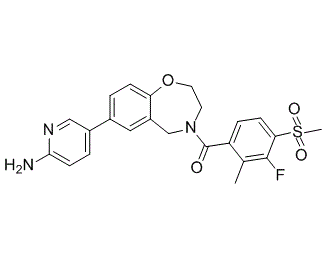| Cas No.: | 1251156-08-7 |
| Chemical Name: | XL-388,XL 388 |
| Synonyms: | XL-388,XL 388 |
| SMILES: | O=C(N1CCOC2=CC=C(C3=CC=C(N)N=C3)C=C2C1)C4=CC=C(S(=O)(C)=O)C(F)=C4C |
| Formula: | C23H22FN3O4S |
| M.Wt: | 455.5 |
| Sotrage: | 2 years -20°C Powder, 2 weeks 4°C in DMSO, 6 months -80°C in DMSO |
| Description: | XL388 is a highly potent and ATP-competitive mTOR inhibitor with an IC50 of 9.9 nM. XL388 simultaneously inhibits both mTORC1 and mTORC2. |
| In Vivo: | To assess the pharmacodynamic effects of XL388 (Compound 28) on the mTOR pathway signaling, athymic nude mice bearing PC-3 prostate tumors are dosed orally at 100 mg/kg of XL388. Rapamycin is also administered intraperitoneally at 5 mg/kg as a reference. Plasma and tumor samples are collected at 1, 4, 8, 16, 24, and 32 h for XL388 and at 4 h for Rapamycin after dosing and homogenized with buffer. Tumor lysates from each animal (n=5) are then pooled for each group and analyzed by immunoblot for levels of phosphorylated p70S6K, S6, 4E-BP1, and AKT. XL388 has moderate terminal elimination half-life (t1/2=1.35 h, 0.45 h, 6.11 h and 0.86 h for mouse (10 mg/kg, iv), rat (3 mg/kg, iv), dog (3 mg/kg, iv), monkey (3 mg/kg, iv))[1]. |
| In Vitro: | XL388 (Compound 28) also inhibits DNA-PK with an IC50 of 8.831 μM. XL388 inhibits cellular phosphorylation of mTOR complex 1 (p-p70S6K, pS6, and p-4E-BP1) and mTOR complex 2 (pAKT (S473)) substrates. XL388 acts in an ATP-competitive manner, with a linear increase in IC50 values with increasing ATP concentration[1]. XL388 shows a dose-dependent effect in promoting MG-63 cell apoptosis. XL388 (100 nM) induces apoptosis in other two OS cell lines (U2OS and SaOs-2), but not in non-cancerous MC3T3-E1 cells. XL388 potently inhibits activation of both mTORC1 and mTORC2 in MG-63 cells. The effect of XL388 on mTORC1/2 activation is again dose-dependent. Further, mTORC1/2 activation is almost blocked in XL388 (100 nM)-treated U2OS cells, SaOs-2 cells and primary human OS cells[2]. |

 To enhance service speed and avoid tariff delays, we've opened a US warehouse. All US orders ship directly from our US facility.
To enhance service speed and avoid tariff delays, we've opened a US warehouse. All US orders ship directly from our US facility.




















